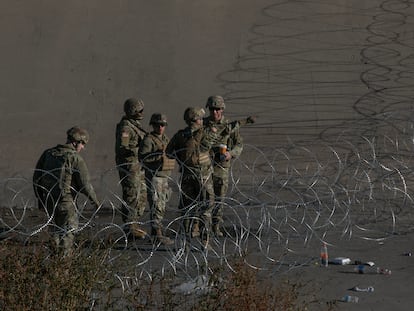At the US-Mexico border, Batman speaks with a Venezuelan accent
Thousands of migrants from Venezuela, stranded at the border between Ciudad Juarez and El Paso in the middle of a cold wave
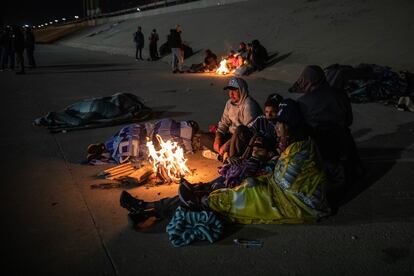

At the border, in the morning, there is a period of two or three hours in which the sun can’t even keep hope warm. Glenys Castro, her sister Marián, their five children (ages six to 17) and their abuelo, Johnny Castillo, try their best to fend off the cold. The winter is tough in Ciudad Juarez, in northern Mexico; more so for a Venezuelan family from Maracay that is used to the Caribbean weather. “I was shocked last night,” says Glenys, 34. “My hands, my feet! Freezing.”
This cold is new for the family. The worst kind is the one they feel when they are kicked out of the shelter at 6am. Still drowsy, the women wake the kids. They sleep with everything on. Outside it is still dark. They go out into the street and see – feel – the hostility of the place. It is not just the cold: it is the geography of the border, inhospitable, made of abandonment, speeding cars, fences and wire, of an imprisoned river. Made of rejection.
The Castro family arrived in Juarez recently, part of an increasing flow of Venezuelan migrants trying to reach the United States by land. In the first 11 months of fiscal year 2022, which ended in September, US immigration authorities registered 154,000 Venezuelan arrivals at the southern border: 216% more than in the same period the previous year, and a record number.
Until October, the citizens of the Caribbean country were allowed to enter the US and request asylum, given the impossibility of the authorities to return them or send them to Mexico, as they did with Central Americans. But then, things changed. In October, right in the middle of the Castro family’s journey, Mexico agreed to also receive Venezuelans; rejected, like Central Americans, in accordance with Title 42, an old directive that was revived during the Trump administration. This measure, still in force, makes it possible to reject foreign citizens, including asylum seekers, alleging health reasons; in this case the Covid-19 pandemic. Although the repeal of the directive seems imminent, the bureaucracy is still keeping it in place.
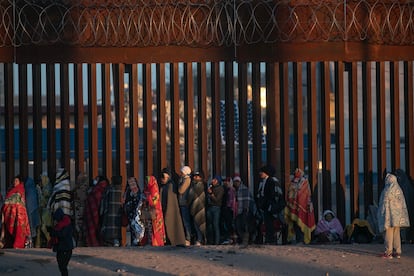
The final months of the year were hard at the border. In November, the first Venezuelan migrants that became stranded in Ciudad Juarez set up a makeshift camp on the banks of the Rio Grande. They were approximately 700. In the United States, terms like “border crisis” or “invasion” began to be used; they were used as political capital but had little to do with the needs of the travelers. At the end of the month, they were “evicted” – one of many euphemisms in the migratory universe. Since then, some have taken advantage of clandestine crossings to get to the other side, but most remain at the river, in shelters or in the street, especially after the deployment of the National Guard, which has installed barbed wire fences in the area.
Corpse water
For the Venezuelans, everything is new. Between those who gather these days in Juarez and El Paso, on the other side of the Rio Grande, and those who have passed through in recent months, they create a migration story that did not exist before; because before, those who migrated left by plane, ranting about the government of Nicolás Maduro, and now those who leave complain about an unlivable life in which a kilo of flour costs $10. That, many at the border explain, can be a weekly salary, sometimes biweekly. Monthly, even.
Those who arrive speak of journeys of three and four months, full of danger and misery, via Colombia, Central America and Mexico. Their stories go across Caracas, Valencia, Maracay, Guarico, in the form of WhatsApp messages and TikTok videos that build on the idea of migrating, making it inviting and reachable. Their protagonists emulate what Cuban or Haitian migrants did before them: long continental journeys to finally reach the coveted north, the United States. The same thing that Guatemalans, Salvadorans, Hondurans and Mexicans have been doing for decades.
In their stories, the Venezuelans speak with pride of their journey inside (or on top) of the freight train that crosses Mexico from south to north, commonly known as La Bestia (The Beast), which leaves a trail of disabled people and is a magnet for the mafias, who see the stowaways as walking money. They talk about the robberies they suffered at the hands of both police and criminals and explain, ashamed, that they have had to beg for money in the streets, in the squares, everywhere.
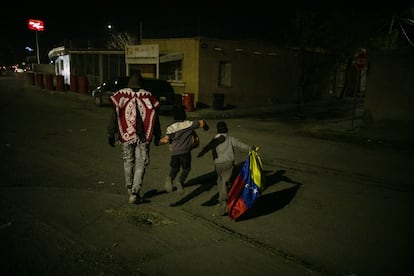
They also talk about the Darien, the deadly jungle that separates Colombia from Panama and which has turned into open season for swindlers and thugs. They all remember those they lost in the Darien and use adjectives such as “horrible” and “inhumane.” The grandfather, Johnny Castillo, a 52-year-old miner and trucker, blurts out: “That’s where we drank corpse water!” The Castro family drank from a river in the jungle in which several bodies were later found.
Batman in El Paso
The Rio Grande separates countries and cities. It divides hopes. On the Mexican side, Venezuelan migrants are waiting for the US government to repeal Title 42 so things can go back to the way they used to be: surrendering to the Border Patrol, requesting asylum and going through the process at their destination. On the Texan side, the hope of those who have already crossed – most of them illegally – is to get some money and leave El Paso.
In the Texan city, at the bus station, a small crowd (many Venezuelans, but also Colombians, Salvadorans and even Mexicans) pleads for some kind of help. In Juarez and El Paso, some local residents have approached shelters and areas where migrants wait, to bring them blankets, food and even toys.
In an alley that smells of urine, a child who is not even two years old plays with a Batman doll. The boy is named Milan, and his game is quite simple: he just takes the doll and throws it as far as he can. From the outside, Batman’s flight can be interpreted as a sort of rejection of his situation, a symbol of exhaustion. His mother, Milianny, 19, says that the child is tired. To fight the weariness, Milan throws the Batman doll, then his sneakers and everything he can reach with his dry, cold hands.
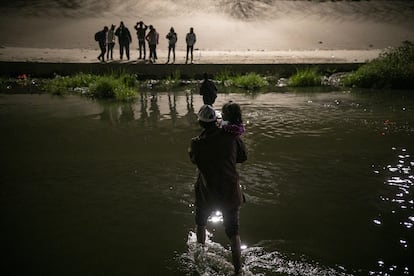
“We got here on Monday,” she says. That was the last time that groups of migrants crossed the Rio Grande before the deployment of the National Guard. “The three of us came; my husband, Milan and I. Our trip took three months. If you only knew! The situation in Venezuela is very hard. You just can’t make a living,” she explains. Their goal is reaching Denver, which for Venezuelans represents the great communications hub of the United States. From there they want to go on to Chicago.
But for now, the priority is to seek shelter. On Christmas weekend, El Paso was expecting below-freezing temperatures due to a cold wave. Milianny had never experienced such cold weather. “We were in a shelter, but they told us that we had to leave, because a lot of locals come and they fight, so it was unsafe for the child.” Concerned for the minor’s well-being, the people in charge of the shelter threw them out on the street.
Sign up for our weekly newsletter to get more English-language news coverage from EL PAÍS USA Edition
Tu suscripción se está usando en otro dispositivo
¿Quieres añadir otro usuario a tu suscripción?
Si continúas leyendo en este dispositivo, no se podrá leer en el otro.
FlechaTu suscripción se está usando en otro dispositivo y solo puedes acceder a EL PAÍS desde un dispositivo a la vez.
Si quieres compartir tu cuenta, cambia tu suscripción a la modalidad Premium, así podrás añadir otro usuario. Cada uno accederá con su propia cuenta de email, lo que os permitirá personalizar vuestra experiencia en EL PAÍS.
¿Tienes una suscripción de empresa? Accede aquí para contratar más cuentas.
En el caso de no saber quién está usando tu cuenta, te recomendamos cambiar tu contraseña aquí.
Si decides continuar compartiendo tu cuenta, este mensaje se mostrará en tu dispositivo y en el de la otra persona que está usando tu cuenta de forma indefinida, afectando a tu experiencia de lectura. Puedes consultar aquí los términos y condiciones de la suscripción digital.
More information
Archived In
Últimas noticias
Most viewed
- Sinaloa Cartel war is taking its toll on Los Chapitos
- Oona Chaplin: ‘I told James Cameron that I was living in a treehouse and starting a permaculture project with a friend’
- Reinhard Genzel, Nobel laureate in physics: ‘One-minute videos will never give you the truth’
- Why the price of coffee has skyrocketed: from Brazilian plantations to specialty coffee houses
- Silver prices are going crazy: This is what’s fueling the rally

